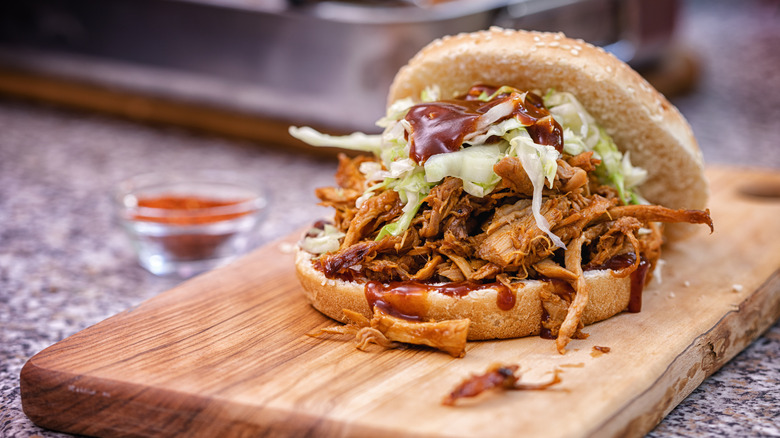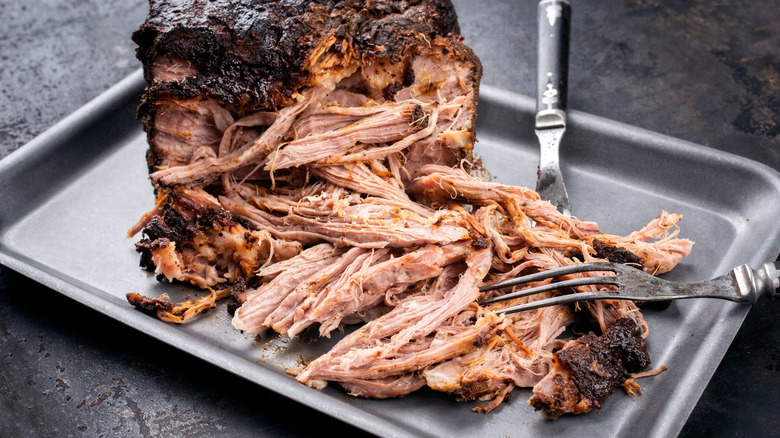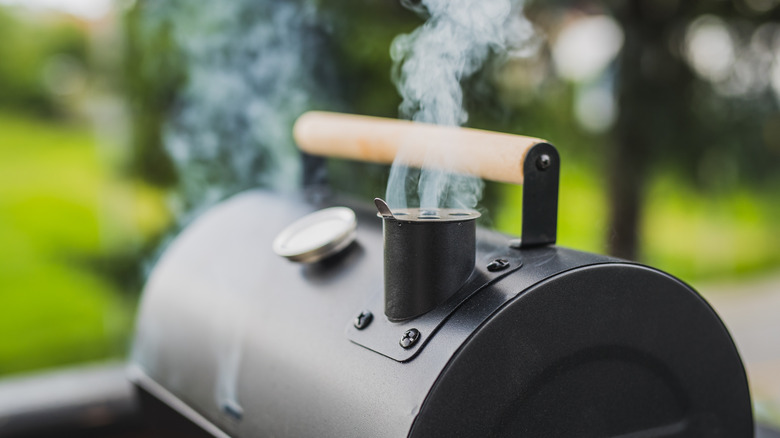Why Pulled Pork Is The Perfect Entry Point Into The World Of Barbecue
People have strong opinions about food, and barbecue is no exception: Debates will always rage over the contemporary geographical wars between pork versus beef, sauces made from vinegar or mustard, and whether "barbecue" is a noun or a verb. As much as you might love a smoky, Texas-style beef brisket, it's a notoriously tough cut to cook — in both senses of the word. Because of this, we can resolve at least one issue regarding barbecue: Pulled pork is the perfect entry point for barbecue beginners because it's affordable, delicious, and forgiving.
All you need to make pulled pork is a well-marbled cut from the shoulder, (optional) smoking wood, temperature control, and time. There's almost no way of messing this process up apart from setting the meat on fire and reducing it to carbon — a catastrophe easily avoided by occasionally looking in on the smoker or grill in between making creamy coleslaw and homemade barbecue sauce — or by simply making pulled pork in the Instant Pot. But why pork, and what the heck does "pulled" mean?
Smokin' a big butt
The ideal meat for pulled pork is not the shoulder, exactly, but a cut from the upper part of a pig's shoulder called the Boston butt. The quality that makes this cut inexpensive is also what makes it easy to cook and unutterably delicious: Boston butts are positively shot through with fat and connective tissue. There's almost no good way of cooking cuts of meat like this except low and slow, which is precisely what the pulled pork cooking method relies on. The ultimate goal is to get the internal temperature of the butt above 135 degrees Fahrenheit; the point at which pork fat will render. Because Boston butts are so well-marbled, they become self-basting (the added cap of fat on top of the cut helps in this regard, too).
This process takes time — rushing it by using higher temperatures will only carbonize the exterior of the meat, and while a succulent piece of pulled pork with a blackened tip is one of life's great joys, burned stuff always tastes bad. The ideal temperature for making pulled pork is having your smoker around 250 degrees Fahrenheit, and you'll need to allow about an hour and a half of cooking time per pound of meat. Once it's done, the fall-apart pork is shredded or "pulled" — so-named because people often do this bit by hand (but it can also be done with forks), discarding the larger globs of rendered fat.
Strategies for delicious pulled pork
To make your pulled pork even more amazing, try a dry rub, which can consist of anything from salt and pepper to more elaborate affairs involving brown sugar, paprika, garlic salt, and other spices. This type of seasoning is all the more vital if you're not smoking the pork butt. You can apply the dry rub up to 12 hours before cooking. It's basically impossible to over-season a Boston butt, so have at it.
Take your meat out of the fridge about a half hour before tossing it in the smoker so it'll cook more evenly. While it's in the barbeque, keep the exterior of the meat cool by spritzing it with apple cider vinegar (or beer!) every hour after the first three hours of undisturbed cooking. Lastly, wrapping the butt in aluminum foil after the fat cap has split and cooking it at a slightly higher temperature for a couple more hours will make it meltingly tender.
As you can imagine, pulled pork can also be made in a low oven as well as the Instant Pot, but to be true 'que it should be smoked. You can use wood chips or chunks for smoking; the only important thing is to maintain the low temperature of your smoker or grill. Once the internal temperature of your pork has reached 200 degrees Fahrenheit, it's done. It's debated if you should rest it before pulling it apart, but resting it for at least 30 minutes allows the juices to redistribute and makes for a deliciously tender bite.


